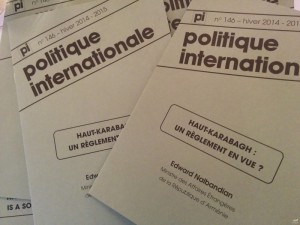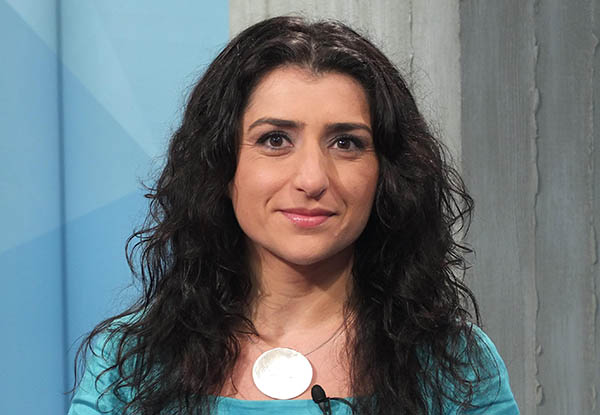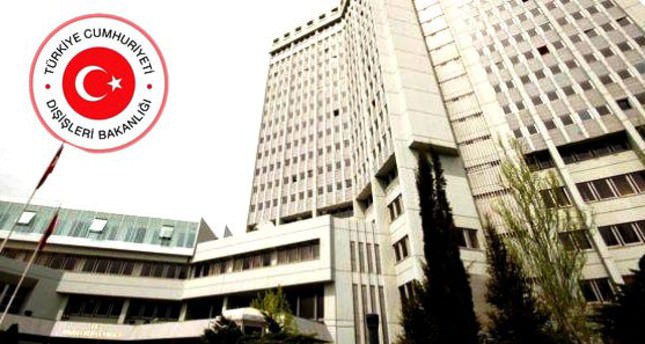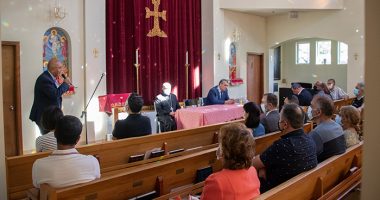One of the most prestigious publications in the political and diplomatic world, the “Politique Internationale” Journal, printed in Paris, published an article by Foreign Minister Edward Nalbandian on the Nagorno-Karabakh issue.


It’s the history of a people who exercised their legitimate right to self-determination. A people who freely expressed their determination and who, for almost a century, have faced the hostility of those who have pretended to be their lords. These are the people of NagornoKarabakh.
It’s the history of a people who exercised their legitimate right to self-determination. A people who freely expressed their determination and who, for almost a century, have faced the hostility of those who have pretended to be their lords. These are the people of NagornoKarabakh.
History
Karabakh (which was called Artsakh for several centuries) was an integral part of the Armenian kingdoms, as proven by the works of authors from antiquity (Strabo, Pliny the Elder, Claudius Ptolemy, Plutarch, Dion Cassius), as well as the many cultural and historical testimonials of Armenian presence (monuments, churches, cemeteries, etc.).
In 1918, after the collapse of the Russian Empire, Armenia, Georgia and Azerbaijan declared their independence. Populated mostly by Armenians, about 95%, Nagorno-Karabakh had de facto sovereignty from 1918 to 1920 (1). From that time, Azerbaijan started to claim this territory and tried to annex it by force. From May 1918 to April 1920, Azerbaijan carried out several massacres against the Armenian population. In March 1920 alone, about 20,000 Armenians were killed and another 20,000 were deported from the then Karabakh capital of Shushi. The illegality of the Azerbaijani actions was underscored by the League of Nations which also turned down Azerbaijan’s appeal for the membership on the grounds that it was impossible to define its borders (2).
With the Sovietization of the Caucasian republics, Azerbaijani leaders received a green light to annex Artsakh.
On July 5, 1921 the Caucasian Bureau of the Russian Communist Party, under pressure from Joseph Stalin, decided to give Karabakh to Azerbaijan. It is noteworthy that this bureau had no authority to make decisions on territorial disputes between the third parties, especially because at the time the Union of Soviet Socialist Republics had not been created yet and Armenia and Azerbaijan were de jure independent republics.
After the end of its occupational program, Baku went even further. While the Caucasian Bureau of the Communist Party planned to create an autonomous region across all of Nagorno-Karabakh, only part of that territory was included in the Nagorno-Karabakh Autonomous Oblast (NKAO). As a consequence, it became an enclave and was deprived of a common border with Armenia.
During the Soviet era the Azerbaijan authorities tried to impede the social-economic development of the region, by carrying out a veritable ethnic cleansing and destroying or appropriating Armenian monuments and cultural heritage. The former President of Azerbaijan, Heydar Aliyev, confessed in one of his interviews (3) that he did everything possible to change the demographics of Nagorno-Karabakh, in favor of Azerbaijanis. In fact, the Armenians, who accounted for 94.4 percent of the population in 1921, were no more than 76.9% in 1989.
The people of Artsakh never accepted Azerbaijani authorities’ policy of depriving them of their right to choose their own destiny. Several times, they brought their case before the Soviet central authorities. Several applications and petitions were sent asking Moscow to reconsider the decision of 1921 and reunite them with Armenia.
The policy of Perestroika launched by Mikhail Gorbachev in 1985 provided an opportunity to reopen the issue. The popular movement for reuniting Nagorno-Karabakh with Armenia (conducted by the “Karabakh” and “Krunk” committees) expanded its scope in 1988, struggling for the end of Azerbaijani oversight and for the right of self-determination. This was one of the engines of the process of liberalization, democratization, the defense of human rights and fundamental freedoms.
On February 20, 1988 the Karabakh Council of People’s Representatives, the local parliament, adopted a resolution asking the Soviet authorities to reunite the autonomous region of Nagorno-Karabakh with Armenia.
The reaction of Soviet Azerbaijan was swift. A new wave of ethnic cleansing against Armenians was launched both in Artsakh and in Armenian-populated parts of Azerbaijan. In February 1988, Sumgait saw a massacre claiming dozens of victims. The violence quickly spread to Baku, Kirovabad and other cities and villages. Hundreds of Armenians were killed during these pogroms, with nearly 400,000 forced to flee, taking refuge in Armenia, Russia and other Soviet Republics.
Legal aspects
On April 3, 1990 a new law was adopted by the USSR, which authorized autonomous entities and compact ethnic groups within a Soviet Republic to freely and independently decide their own legal status in case the Republic secedes from the USSR. Following Soviet Azerbaijan’s declaration of independence on August 30, 1991, Nagorno-Karabakh initiated the same legal procedure by adopting its own declaration of independence. In the referendum of December 10, 1991, organized in the presence of international observers, the people of Nagorno-Karabakh voted for independence with an overwhelming majority (over 99% of votes).
This referendum, which was held at a time when Nagorno-Karabakh was part of the USSR, was fully in line with Soviet law. Logically, the day after the collapse of the Soviet Union two states were created on the territory of the former Azerbaijani Soviet Socialist Republic: Nagorno-Karabakh Republic and the Republic of Azerbaijan.
Over the years, the European Parliament had adopted numerous resolutions in support of Nagorno-Karabakh’s strife for selfdetermination. In its resolution of June 21, 1999 on Nagorno-Karabakh, the European Parliament stated that “the autonomous region of Nagorno-Karabakh declared its independence following similar declarations by former Soviet Socialist Republics after the collapse of the USSR in September 1991.”
Peoples’ right to self-determination is a fundamental right enshrined in the Charter of the United Nations and reaffirmed by several other core international documents.
Not having any legal argument against the independence of Nagorno-Karabakh, Baku tried to represent the problem as a territorial dispute between Armenia and Azerbaijan.
The conflict and the peace process
In Nagorno-Karabakh and the surrounding areas populated by Armenians, the ethnic cleansing by Azerbaijani authorities quickly turned into large-scale military actions resulting in tens of thousands losses and causing considerable destruction. Azerbaijan used mercenaries in this war, mainly Afghans and Chechens, closely linked to the notorious terrorist organizations.
Such serious violations of international law did not avoid from the attention of the international community. In 1988-1991 the U.S. Congress on several occasions condemned the aggression of Azerbaijan against Armenian civilians. Moreover, in 1992 it approved Section 907 of the Freedom Support Act, restricting the U.S. aid to Azerbaijan because of Azerbaijan’s aggressive policy and the blockade against Armenia and Nagorno-Karabakh.
The Security Council of the United Nations adopted four resolutions in 1993 urging immediate cessation of hostilities, opening of communications and the resumption of peace talks with all parties concerned, including Nagorno-Karabakh. In response, Azerbaijan just intensified its military offensives. But on the ground the balance of strength turned to its disadvantage, and it soon had no other option but to request a cease-fire from Nagorno-Karabakh.
In May 1994, the cease-fire agreement between Nagorno-Karabakh and Azerbaijan was signed, also joined by Armenia. A new trilateral agreement on the consolidation of the cease-fire was signed in February 1995. Both agreements are continuously violated by Azerbaijan.
Starting from the mid-1990s the peace talks have been mediated by the Co-Chairs of the OSCE Minsk Group, comprising France, Russia and the United States. In the first phase, the peace negotiations involved three parties — Armenia, Azerbaijan and Nagorno-Karabakh. However, in the late 1990s Azerbaijan broke off all talks with Nagorno-Karabakh. In order to preserve the peace process, Armenia continued negotiations, believing that Nagorno-Karabakh would eventually have to be involved. In fact, it will be impossible to reach a lasting settlement without its participation; and this view is fully shared by the Co-Chairs.
The Minsk Group Co-Chairs spared no efforts, organizing regular high-level talks and shuttling between Baku, Stepanakert and Yerevan. But their efforts were in vain, since all peace efforts were undermined by Azerbaijan. In 2001 the parties met in Paris and came close to a settlement. Unfortunately, Heydar Aliyev, the President of Azerbaijan at the time, and the father of the current president, backtracked from the agreements reached in the French capital.
Basic Principles
In November 2007, during the OSCE Ministerial Council in Madrid, the Co-Chairs presented the basic principles of the Nagorno-Karabakh conflict settlement, which later became known as the “Madrid Principles”.
Azerbaijan at first publicly refused to accept the very existence of the Madrid proposals. Subsequently, Baku sought to falsify the essence of the document and misinterpret the content of the peace process.
The Co-Chair countries were obliged to make public the main principles of the Madrid Document, which drew on three fundamental principles of international law: non use of force or the threat of force; peoples’ right to self-determination; and territorial integrity.
The main elements of the proposals were also revealed: determination of the final legal status of Nagorno-Karabakh through a legally binding expression of the will of the population of Nagorno-Karabakh; an interim status for Nagorno-Karabakh until the organization of the free expression of the will; multilayer security guarantees, including a peacekeeping operation around Nagorno-Karabakh; return of the territories surrounding Nagorno-Karabakh; a corridor linking Nagorno-Karabakh to Armenia; the right of all refugees and internally displaced persons to return to their former places of residence.
Azerbaijan rejected each of these points. Not only did it attempt to change the essence of the negotiating process, but also to distort the nature of the conflict within various international bodies, not hesitating to mislead the international community by presenting the consequences of the conflict as its causes.
The Minsk Group Co-Chairs stated at the OSCE 2010 Astana summit that “These proposed elements were conceived as an integrated whole, and any attempt to select some elements over others would make it impossible to achieve a solution.”
From 2008 to 2011, former Russian President Dmitry Medvedev considerably contributed to the peace process. He organized a number of trilateral talks with the participation of the Presidents of Russia, Armenia and Azerbaijan, where the parties adopted four declarations (4).
To support the efforts for a peaceful settlement, the presidents of the three Co-Chair countries adopted five statements (5). Statements on the Nagorno-Karabakh conflict were also adopted within the framework of the OSCE Ministerial Conferences and OSCE Summit (6).
Armenia welcomed all these statements and expressed its readiness to settle the conflict on the basis of the proposals contained therein.
However, Azerbaijan not only failed to endorse these statements, it rejected all versions of the Basic Principles of the Nagorno-Karabakh conflict settlement proposed by the Co-Chairs of the Minsk Group, including the latest proposals submitted at the Saint-Petersburg (June 2010), Astrakhan (October 2010), Sochi (March 2011) and Kazan (June 2011) summits.
We went to the Kazan meeting, initiated by then President Medvedev and supported by Presidents Obama and Sarkozy, with a positive outlook and feeling that we could reach an agreement on the Basic Principles. The American and French presidents used all their weight. Armenian President Serzh Sargsyan, during his speech in the Parliamentary Assembly of the Council of Europe in Strasbourg just before the meeting, stated that it would be possible to expect positive results if Azerbaijan did not propose new amendments. But, once again, the Kazan Summit did not reach a breakthrough, despite everybody’s raised hopes. Azerbaijan did an about-face at the last moment, suggesting ten amendments to the text which had already been agreed. It was a repetition of the scenario at the previous meetings.
The aftermath of the Kazan Summit
The Kazan Summit was followed by almost two years of stagnation in the peace process. Azerbaijan’s negative attitude not only undermined the negotiations, but also destabilized the situation on the ground. During this period Azerbaijan multiplied its ceasefire violations and provocative actions along the line of contact between Nagorno-Karabakh and Azerbaijan and along the border between Armenia and Azerbaijan.
The Co-Chairs are internationally mandated to facilitate the peace process, as well as to help preserve and strengthen the existing ceasefire. They proposed a number of Confidence and Security-Building Measures (CSBM) — consolidation of the ceasefire, withdrawal of snipers from the line of contact, creation of a mechanism to investigate incidents and violations of the cease-fire agreement. These proposals were endorsed by a number of major international organizations, as well as the UN Secretary General. They were equally welcomed by Armenia and Nagorno-Karabakh. But all of them were rejected by Baku.
Azerbaijan also refused implement what has been agreed by President Aliyev on creation of investigation mechanism (Sochi declarations of March 5, 2011 and January 23, 2012). It even threatened to veto the entire OSCE budget for 2012 if any funding was allocated to the creation of this type of investigation mechanism.
Armenia has always supported the implementation of the Confidence and Security Building Measures (CSBMs). We believe that these measures will help create favorable conditions for negotiations. Azerbaijan takes the opposite point of view and only considers the implementation of these measures once progress on the settlement has been achieved. Which makes no sense, because it is obvious that if we manage to reach a solution, there would be less need for the measures! It is also obvious that without mutual confidence between the parties, no solution is possible.
Armenophobia in Azerbaijan
Baku is blatantly encouraging anti-Armenian xenophobia. Azerbaijani President Aliyev declared Armenians all over the world are the “Number 1 enemy” of Azerbaijan.
This anti-Armenian propaganda reached its apogee with the Safarov affair. In 2004 this young Azerbaijani serviceman, who was attending a NATO training session in Hungary, killed a sleeping Armenian officer, with an axe, solely because he was Armenian. Convicted in Hungary, where he was jailed, he was finally extradited in 2012 to Azerbaijan, where he was immediately pardoned and glorified. The Azerbaijani leadership made him a symbol of national pride and an example for youth, earning the disapproval of the whole world. The Council of Europe’s Commissioner of Human Rights warned that “to glorify and reward such a person flies in the face of all accepted standards for human rights protection and rule of law.” The European Parliament President and Parliamentary Assembly of the Council of Europe President also expressed their concern. The United Nations High Commissioner for Human Rights said that “ethnically motivated hate crimes of this gravity should be deplored and properly punished – not publicly glorified.” However, despite these warnings, Baku still maintains that what it did “is very good and right” and dares to criticize the stance of the international community.
A top level meeting between the presidents of Armenia and Azerbaijan resumed in Vienna in November 2013, thanks to the efforts of the Co-Chairs, some time after the notorious “Safarov case”, and there was some hope that the negotiations could move forward. Once more, those expectations were not met, as Azerbaijan did everything to destabilize the situation in the conflict zone.
The Azerbaijani side made several incursions, resulting in many deaths, and drastically raising tension on the ground. An Armenian villager who had mistakenly strayed into Azerbaijan territory was arrested, humiliated in front of the TV cameras — a tactic used by notorious terrorist organizations — and executed the following day.
In Azerbaijan, journalists, activists and the intelligentsia are all persecuted as “Armenian spies” and “enemies of the nation”, just because they are advocating peace and reconciliation. The writer Akram Aylisli was ostracized for publishing a novel (7), where he talks about the pogroms against Armenians in Baku and Sumgait. His books were publicly burned and the writer had to leave the country because of threats on his life.
Armenophobia is becoming a constant of political discourse in Azerbaijan. Those who are courageous enough not to blindly follow the propaganda of the authorities of Azerbaijan are rapidly disappearing from the stage. The distortion of history and propaganda have reached such an extent that Armenia, and even the several millennia-old city of Yerevan, are being declared ancient territories of Azerbaijan.
At a time when the protection and promotion of human rights are considered to be fundamental concepts, intolerance towards the values of foreign civilizations, and the degradation or systematic destruction of cultural or religious heritage must be condemned with the same resolve and determination as violence against people.
The systematic destruction by the Azerbaijanis of many Armenian architectural masterpieces and sacred sites, including the destruction between 1998 and 2005 in Nakhichevan (8) of thousands of delicately carved cross stones by Armenian masters dating from the 9th to the 16th centuries, is vivid proof of these crimes.
Thousands of these giant medieval sculptures were bulldozed under the Azerbaijani government’s watchful eyes and this area was turned into a military zone in a government sanctioned operation. The 16th International Council on Monuments and Sites (ICOMOS) General Assembly resolution condemned this vandalism in no uncertain words: “This heritage that once enjoyed its worthy place among the treasures of the world’s heritage can no longer be transmitted today to future generations.”
Many international organizations also warned about flagrant cases of racism, intolerance and violations of human rights in Azerbaijan and the policy of hatred against Armenians. The European Commission against Racism and Intolerance (ECRI), in its report on Azerbaijan, noted with deep concern the “constant and negative official and media discourse concerning the Republic of Armenia” and recommended that Azerbaijani authorities “adopt an appropriate response to all cases of discrimination and hate speech against Armenians”. In response, Baku merely organizes fake conferences on tolerance and freedom, in an attempt to impose its own distorted perception of human rights on others.
Azerbaijan, a threat to regional security
With its long experience in domestic corruption, Azerbaijan is attempting to transfer this “expertise” to foreign relations. In foreign capitals and international organizations, lobbying teams seek to justify Baku’s aggressive policies.
The Minsk Group Co-Chairs — the Russian President in Sochi (August 2014), the American Secretary of State in Newport (September 2014), and the President of France in Paris (October 2014) — organized summit meetings with participation of the Heads of States of Armenia and Azerbaijan to reduce tensions and avoid further escalation. Azerbaijan once again refused François Hollande’s proposals on Confidence Building Measures at the Paris summit.
Immediately after those meetings the Azerbaijani authorities’ raised another wave of anti-Armenian rhetoric. The Defense Minister of that country claimed again that his country would solve the Nagorno-Karabakh issue through military means and bragged about a 27% increase in Azerbaijan’s military budget! The budget will reach $4.8 billion in 2015, a 30-fold increase since 2003, when Ilham Aliyev succeeded his father as Head of State.
The latest provocation: in November 2014, a Nagorno-Karabakh Defense Army helicopter was shot down during a training flight by Azerbaijani forces. Three young servicemen were killed. The Azerbaijani army kept the area under continuous fire for almost ten days, hindering rescue teams and preventing OSCE and International Committee of the Red Cross representatives from approaching the site. A request by the OSCE Minsk Group Co-Chairs to open a humanitarian corridor to evacuate the bodies of the crew members was refused as well. Facing yet another gross violation of international humanitarian law by Azerbaijan, the Nagorno-Karabakh Defense Army had to undertake a special operation to recover the bodies.
Baku continues to oppose the Minsk Group and the international community. It is not only ignoring calls to implement confidence-building measures, but is even pouring oil on the fire, making them fully responsible for escalating the conflict.
For the last twenty years, Azerbaijan has done everything in its power to undermine the cease-fire agreements. Military actions along the line of contact and on the Armenian-Azerbaijani border have resulted in significant loss of life and greatly raised tensions on the ground. All the statements and decisions by Baku’s authorities prove that Azerbaijan has become a serious threat to security and stability in the South Caucasus. This country has lost its sense of reality and is doing its utmost to undermine the peace talks. That is why, despite the intensive efforts of the three Co-Chair countries during the last six years (twenty summits, several dozen ministerial-level meetings, visits by the three Co-Chairs to the region), it has not been possible to achieve a breakthrough in negotiations.
Azerbaijan is undertaking a relentless campaign of denigration against the Minsk Group Co-Chairs. It also continuously attacks the Personal Representative of the OSCE Chairman-in-Office (who is trying to prevent the escalation of the situation, along with his team). Azerbaijani officials are trying to shift the settlement process to different format from the OSCE Minsk-Group Co-Chairmanship.
In fact, Baku is not interested in anything but its own advantage. That explains why they deliberately undermined recent Summits (Saint-Petersburg in June 2010, Astrakhan in October 2010, Sochi in March 2011, and Kazan in June 2011). Armenia deplores this attitude. It considers, along with the Co-Chairs, that any maneuver to delay the negotiations on achieving a balanced agreement on the basic principles is unacceptable.
Is settlement possible?
We continue to believe that the principles and elements outlined in the statements of the heads of the Co-Chair countries over the last six years can be the foundations for reaching a fair and lasting settlement of the conflict.
We absolutely agree that peoples should be prepared for peace, not war. Unfortunately, until now the Azerbaijani leadership is doing just the opposite. Unlike Azerbaijan, Armenia, in response to the call by Presidents of the Co-Chair countries, has reiterated and once again reaffirms its commitment to the principles of international law.
We fully agree with the heads of the Co-Chair countries that the use of force will not resolve the conflict, and that only a negotiated settlement can lead to stability and peace, which will open new opportunities for regional cooperation and development. The sooner the Azerbaijani leadership understands this reality, the faster the conflict can be settled.
The day that Azerbaijan gets rid of its illusions, the day that it realizes that it’s not by pouring its oil revenues into its strategy of endlessly increasing military tension that it can achieve a solution in its favor, on that day, I repeat, we can hope for tangible progress in the peace process. Armenia will spare no efforts to achieve the settlement of the conflict exclusively by peaceful means.
*****************************
(1) During the years 1918-1920, the power in Nagorno-Karabakh was held by the Assembly of Armenians of Karabakh, which declared, on July 22, 1918, that Nagorno-Karabakh is an independent political entity. It elected a National Council, or Parliament and a democratic government.
(2) Decision of the 5th Commission of the Assembly of the League of Nations, December 1, 1920.
(3) Zerkalo, Azerbaijan, July 23, 2002.
(4) In Mayendorf (November 2, 2008), Astrakhan (October 27, 2010) and Sochi (March 5, 2011 and January 23, 2012).
(5) In L’Aquila (2009), Muskoka (2010), Deauville (2011), Los Cabos (2012), Eniskilen (2013).
(6) In Helsinki (2008), Athens (2009), Almaty (2010), Vilnius (2011), Dublin (2012), Kiev (2013), Basel (2014), and during the OSCE Summit in Astana (2010).
(7) “Stone Dreams”, Druzhba Narodov, 2012.
(8) – Stephen Castle “Azerbaijan ‘flattened’ sacred Armenian site”, The Independent, 30 May 2006;
– Sarah Pickman “Tragedy on the Araxes”, archaeology.org, 30 June 2006;
– “U.S. Envoy barred from Armenian cemetery in Azerbaijan”, RFE/RL, 22 April 2011.










